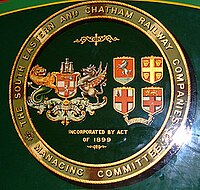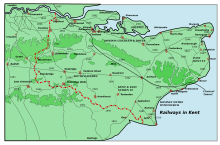Our website is made possible by displaying online advertisements to our visitors.
Please consider supporting us by disabling your ad blocker.
South Eastern and Chatham Railway
 | |
 1920 map of the railway | |
| Technical | |
|---|---|
| Track gauge | 4 ft 8+1⁄2 in (1,435 mm) |
| Length | 637 miles 61 chains (1,026.4 km) (1919)[1] |
| Track length | 1,302 miles 24 chains (2,095.8 km) (1919)[1] |
The South Eastern and Chatham Railway Companies Joint Management Committee (SE&CRCJMC),[2] known as the South Eastern and Chatham Railway (SE&CR), was a working union of two neighbouring rival railways, the South Eastern Railway (SER) and London, Chatham and Dover Railway (LC&DR), which operated between London and south-east England. Between 1899 and 1923, the SE&CR had a monopoly of railway services in Kent and to the main Channel ports for ferries to France and Belgium.
The companies had competed extensively, with some of the bitterest conflicts between British railway companies. Competing routes to the same destinations were built, so several towns in Kent had been served with a similar frequency service by both companies. In places, unfettered competition allowed two stations and services to multiple London termini.
It would be a constituent of the Southern Railway as part of the 1923 Grouping.

Previous Page Next Page


